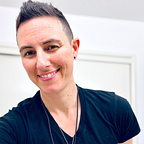What is a Service Experience? (explained through drawings)
It’s been almost two months since I started my new job as a service designer, helping kickstart a small, in-house design team from the ground up. Over the past two months, I’ve been working on defining our mission, vision, strategy, process, and methods. One of the biggest challenges I have faced is how to communicate core service design concepts to my colleagues.
As far as I know, I am one of only three people in my 500-person organization that has the word “designer” in my job title. Not that job titles are the best reflection of what people do, but it does say a lot about the landscape I am working in — it’s a landscape where most of the people I work with day-to-day have never worked with a designer before.
How do you build a bridge between two languages, two worlds, two mindsets? How do you start to draw people into the vision of a human-centered approach to designing service experiences?
We have to drop the jargon, and find a narrative to help cement core concepts. This is where I’ve discovered my secret weapon: drawing pictures.
Almost everyone I meet, whether they are in finance, billing, development, support, leadership, are all craving visual communication. I’m not talking about complex diagrams. I’m talking about simple pictures that capture the essence of a core concept. Something that is sticky. Something that can be re-drawn easily on the fly if it comes up in conversation. If you are taking time to explain something — anything! — then you should try to draw a picture of it.
A challenge (I mean, opportunity)
Last week, my VP asked me to do a five-minute presentation on take-aways from the Service Experience Conference. As I mulled over what my take-aways were (read more here), I came to the conclusion that this presentation was more of an opportunity to introduce some core service design concepts to my division (about 50 people).
So, how do you explain service design in less than five minutes? This is the classic challenge that I am facing almost daily, which is, “What is the elevator pitch for service design?”
So I want to share with you a short visual explanation I’ve been developing that helps answer the question, “What is a service experience?”
Here goes:
Let’s draw!
Service Design is breaking new ground, into new industries every day, and I believe that it can be a vehicle for many people who consider themselves to be non-designers to make significant contribution and join the movement. But we have to break free of the textbook-style way we explain design concepts. Capital-D Designers, I love you (I am one of you), but we have to use our design super-powers to help build something bigger — changing mindsets, the way people think, and giving them the tools to work in a new way. A concept is a tool, and vice versa, and as designers, we are in the business of both. I believe that we can do this better by drawing more pictures.
So, I challenge you to contribute to the cause! Do you have sketches that have helped explain core concepts of service design to your organizations? I’d like us as a community to build a library of core concept drawings, and would love for you to contribute.
